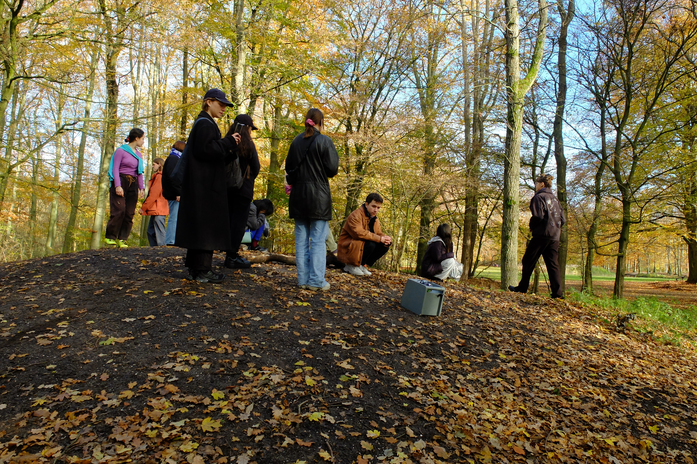Outro
The reason for an "outro" rather than a conclusion is that there is a whole album's-worth of work still to be done.
I find the sustainable re-activation of the earlier pieces in itself an interesting project and one that requires further research, production and funding to complete. Some of the earlier pieces will require changes to the Tracks app itself. The insights gained during this year will feed into my teaching practice as well as possible future solo works. The experience of using Tracks along with the exploration of aural perception in relation to walking and engagement will certainly inform the collaborative two-year research project Sounding Urban Spaces which is just starting up.
During the latter part of this research, I worked with a group of students on a series of audio walks, encouraging them to explore the use of headphones and locative media. Listening to their pieces has been a real ear-opener for me.
One group ditched the headphones completely for their procession through a park with portable loudspeakers. The sounds did truly blend (and compete) with the sounds of the environment, but also, by leaving space for listeners to move around and hear things from different perspectives, they encouraged interaction and engagement. Standing around a loudspeaker concentrated the listening of the whole group, even when it was not producing any sound.
Another group, using Echoes - a precursor of Tracks, made a conceptual map where streets were divided between acoustic musical passages and electronic sonic textures. Junctions were marked with spoken texts. This allowed the listener to engage with the meta-composition and navigate through the city at the same time.
In a headphone-based walk inside a building we were asked to "walk in the rhythm of the footsteps" that we could hear on the soundtrack. Not only does this set the pace but, as another listener noted, it makes you move in a certain way. You can feel the body of the person who recorded the sound - in fact, you listen with your whole body.
The research continues but one thing is clear to me already: the process of engagement or detachment from the surroundings in an audio walk is not just about sound. Listening has often been fetishized and contrasted with vision as a way of knowing the world. It is of course possible and useful with exercises and training to isolate listening from other senses to allow us to focus on our engagement with the audible, but listening is not just about our ears.
As François Bonnet puts it, "Listening is always a stretching toward, and it never stops at sound. It traverses it, goes through it to arrive at something else, something that still belongs to the domain of sensation but also, already, that of language."
- and our hearing mechanism uses input from all our other senses to balance, adjust and focus our interpretation of sound. Our perception of a sound can be altered by a colour, a scent, a suggestion, by how we stand, sit or move, by the weather and the time of day.
Shaping the context, the dramaturgy of a walking route, giving directions, playing with external and internal sound, the use of geo-location or managing the theatrical elements of a walk can all play a part in organizing the engagement of the listener. The audio walk on headphones becomes a kind of interface between the listener and their surroundings, one that can speak to different modes of listening and relating to our environment. The "space of bodily presence" created by listening can be modulated through the composition of the walk, sometimes extending itself to engage the subject with the surroundings in general, or with an object in particular. (Re)discovering and applying concepts like synchresis, atmospheres and proprioception has given me tools to think about what I and others do in audio walks which I expect to be also very useful in my teaching practice.
Music in an audio walk can play the role of a trickster, just like in the cinema, where it can slip between the diegetic and the non-diegetic. Apparent environmental sound can become music and vice-versa. It can trick us into becoming immersed in sound, lost in music before dumping us back into reality or back into fiction. Looking back at the older pieces I realise that I was already working with this, be it in an intuitive manner. I've started to see "sledgidity" as not so much of a problem, but something that can be actively played with as an element in a piece. Not worrying so much about being caught in the trap of immersion, I've started to enjoy being lost.
Thanks to: Paul Craenen, Roos Leeflang and the colleagues from the Lectorate Music, Education and Society, Royal Conservatoire The Hague, students and staff of the Institute of Sonology, all my artist-researcher colleagues from Jubilee, Renate Zentschnig and Michiel Huijsman from Soundtrackcity, Q-O2, Margot Edström, Christian Skovbjerg-Jensen, Elena Biserna, Alice Twemlow, and the Rewire Festival.
This exposition is dedicated to Cilia Erens. I wish I'd asked more questions.

